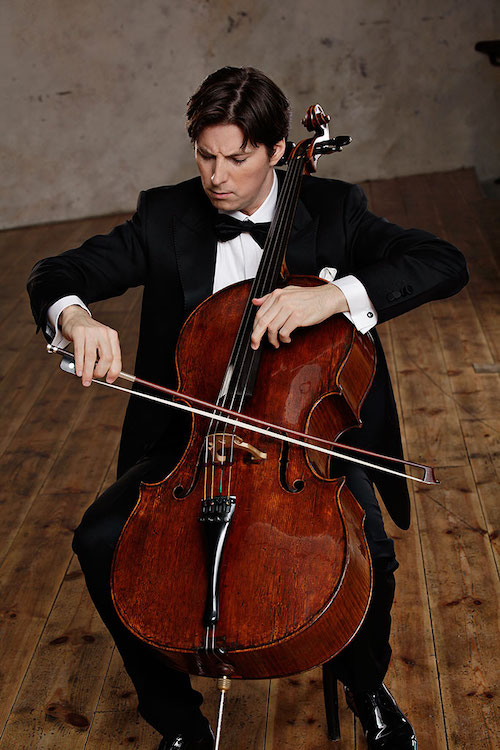Albrecht leads a reconfigured Dallas Symphony in Strauss, Chun and Shostakovich

Most orchestras, including the Dallas Symphony Orchestra, tend to follow the disposition of instruments established by Leopold Stokowski in the 1930s, which places the first and second violins stage right and the violas and cellos stage left.
Stokowski’s innovation optimized tone quality and distinguished tune from accompaniment in the recording setting, proving more versatile as new concert hall designs were increasingly experimenting with acoustic properties. Though his layout has since been accepted as the standard, the older traditional formation is still preferred by many conductors, arguably for its balancing effect in distinguishing each part’s textural nuances in live performance.
Marc Albrecht is one such conductor. Leading the DSO at the Meyerson Symphony Center Thursday evening in a program of Shostakovich and Strauss works, he demonstrated the aural benefits of the previous layout tradition: Violins split left and right, with violas and cellos and basses behind respectively. While colors and textures were beautifully balanced throughout most of the concert, rhythmic cohesion sometimes suffered.
In solidarity with Ukraine, the concert opened with a late addition of Ukrainian composer Myroslav Skoryk’s Melody, arranged for string quartet. Dark and poignantly moving, it was performed adeptly by DSO concertmaster Alexander Kerr and principals, violinist Angela Heyde, violist Meredith Kufchak, and cellist Christopher Adkins.
Unsuk Chin’s 2019 Frontispiece followed, receiving its Dallas premiere. Commissioned by the NDR Elbphilharmonie Orchestra, it is a variegated work combining fragments of various composers and their distinctive styles in a clever reinterpretation that conveys music’s evolution through history. In it, colors smash into each other and then blend together beautifully. Under Albrecht, the DSO served up a smartly executed performance.
Shostakovish’s Cello Concerto No. 1, composed in 1959, brought solo virtuosity and expression from guest artist Daniel Müller-Schott. The four-note musical transliteration of composer’s musical signature four-note motif “DSCH” serves as the framework for the opening theme, which characterizes all but the second of four movements.

Albrecht managed a fluid, shimmery mix of tone textures from the chamber orchestra accompaniment, however, metric shifts and brisk tempo passages were less than tight in coordination with the soloist.
Müller-Schott’s exposition of the material was impassioned and muscular in the cadenza—a movement reserved for showcasing the soloist exclusively on variations of the “DSCH” motif. The Moderato was dark and even-tempered, with a low-end opening and buoyant accompaniment from the winds. The ghostly transition into the third movement, played attaca, was augmented with lovely blooming tones from the celeste.
Again, there were moments that felt rhythmically disjointed between soloist and ensemble, particularly in the pizzicato passages of the frenzied finale. Acting principal horn David Heyde provided confident heralding statements, equal in facility to Müller-Schott.
The second half of the concert was devoted to Strauss’ Symphonia Domestica. In this 45-minute tone-poem, Strauss—a champion of programmatic music—reimagines himself, wife Pauline, and their young son Franz as musical motifs to paint a world reflective of his bourgeois lifestyle. The four-movement work depicts his family life—the bliss and tensions of marital partnership, a baby’s squall, vivid dreamscapes, and the playfulness of youth. It is composed for grand orchestra, with every element presented along with double-reed oboe and saxophones.
While some parts of the sequence were played way too loudly, the commitment to drama and narrative were never lost under Albrecht’s lithe direction. The family fight, frenetic and high in energy, was impactful and bracing, while lighthearted passages depicting the young boy’s mischievousness were light and bouncy.
The half-dozen false endings were executed with a joviality that proved infectious—evidenced by swells of stifled laughter from the audience. And thought the “joyous confusion” of the finale was at times cacophonous, a stunningly bright finish punctuated an otherwise solid night of playing.
A stark, notable clarity of string tones provided by this orchestra layout characterized the program with a brilliance befitting the Meyerson’s acoustic design. However, the DSO may require more showings in this alignment to fine-tune overall cohesion and rhythmic tautness.
The program will be repeated 7:30 p.m. Saturday and 3 p.m. Sunday. dallassymphony.org